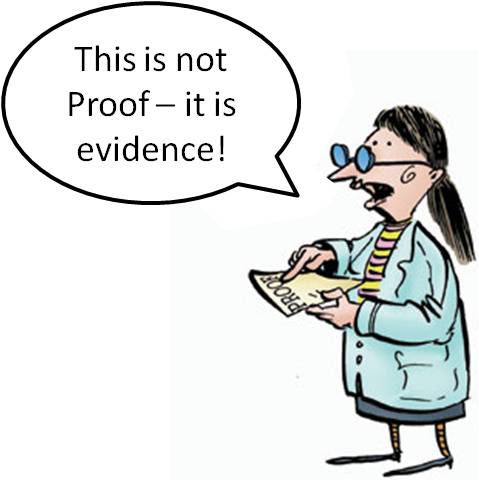Fingerprints at the crime scene
Investigating the scene of a crime
Watch the video below to discover how quickly a Police forensics specialist can identify which fingerprints belong to each of two students.
 What we would all like in life is proof; some firm evidence that would confirm to us that our ideas or beliefs are 100% correct … but proof is a slippery concept and indeed, scientists prefer not to talk about ‘proof’ at all.
What we would all like in life is proof; some firm evidence that would confirm to us that our ideas or beliefs are 100% correct … but proof is a slippery concept and indeed, scientists prefer not to talk about ‘proof’ at all.
They insist it is more useful to talk about evidence – and if the evidence really stacks up to support a claim, then we can be (reasonably) confident the claim is true. They say (be warned) you can never ever ever really ‘PROVE’ anything in science at all!
 With maths, it’s a different story and mathematicians consider that a ‘mathematical proof’ is a very fine thing indeed.
With maths, it’s a different story and mathematicians consider that a ‘mathematical proof’ is a very fine thing indeed.
But back to science. In science, the method of testing and verifying ideas is strictly set out. A scientific idea (or theory) is an idea that can be supported using ‘observations’ (such as measurements) and those measurements must be available for others to evaluate.
 Here’s an example. There is a theory that your fingerprints are unique. The evidence which supports this theory is that scientists have compared countless fingerprints and so far, no two have been the same. Scientists say that each one of your fingerprints is different – and even twins (before you ask) have different prints. (There is also a theory to explain why this is – which is that your experiences in the womb affect how your fingers grow and how your fingerprints turn out.)
Here’s an example. There is a theory that your fingerprints are unique. The evidence which supports this theory is that scientists have compared countless fingerprints and so far, no two have been the same. Scientists say that each one of your fingerprints is different – and even twins (before you ask) have different prints. (There is also a theory to explain why this is – which is that your experiences in the womb affect how your fingers grow and how your fingerprints turn out.)
Society’s confidence in the ‘Unique Fingerprint theory’ is now so high that fingerprints can be used in court to ‘prove’ that a suspect has visited a crime scene. Even so, if we do suddenly find two people with identical fingerprints … ouch! Suddenly the theory is in trouble!
Play the game and practise some observational skills!
On the evidence of a fingerprint …
Is a fingerprint enough – in your view – to be convincing evidence that a suspect has visited the scene of a crime? Here’s what two students from Wallingford School say:
Yes, fingerprinting would be enough to convince me in a court case that a certain person had been at the scene of the crime. I don’t think it is enough evidence to say that person is actually the criminal, and of course the fingerprints could have been faked. So I don’t believe that a fingerprint is 100% accurate, but it is at least a start, and with other evidence it can lead to a very reliable conclusion.
In my opinion, a fingerprint on its own is not enough to entirely convince that the person was at the crime scene. I do not doubt the accuracy of fingerprinting – it has proved to me to be a reliable process – but it can never tell if the person was at the crime scene as part of the crime, or taken there by the criminals themselves and forced to leave fingerprints.
Because of this, I think that a fingerprint on its own should not convince that the person was there – it could be a forged/framed fingerprint – but can definitely provide substantial evidence when stacked with other pieces.
On the next page, find out about the Big Bang Theory move to the next page